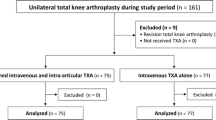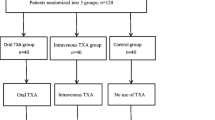Abstract
Introduction
A randomised, double-blind clinical trial was conducted comparing the efficacy of tranexamic acid (TXA) as a single intravenous bolus or a continuous infusion to patients undergoing total knee arthroplasty (TKA). Study hypothesis was that a second dose of TXA would not offer any clinical benefits over the single infusion.
Materials and methods
One hundred and six patients were randomised to a single intraoperative dose of 30 mg/kg tranexamic acid (OS group, n = 54), or to a loading dose of 10 mg/kg tranexamic acid followed 2 h later by a continuous 2 mg/kg/h infusion for 20 h (OD group, n = 52). The primary outcome was blood loss calculated from haematological values and perioperative transfusions. Secondary outcomes included the occurrence of major complications within the first postoperative year.
Results
All patients completed tranexamic acid therapy without adverse events. The mean blood loss was 1,148 ± 585 ml in group OS and 1,196 ± 614 ml in group OD (p = 0.68). No patients received a transfusion. There were no occurrences of major complications up to 6-weeks follow-up.
Conclusions
The study demonstrated that a single bolus of tranexamic acid 30 mg/kg is as effective as a continuous infusion in patients undergoing tranexamic acid. The single application of tranexamic acid as part of routine care is recommended.

Similar content being viewed by others
References
Zufferey P, Merquiol F, Laporte S, Decousus H, Mismetti P, Auboyer C, Samama CM, Molliex S (2006) Do antifibrinolytics reduce allogeneic blood transfusion in orthopedic surgery? Anesthesiology 105(5):1034–1046
Goodnough LT (2005) Risks of blood transfusion. Anesthesiol Clin North Am 23(2):241–252
Spahn DR, Casutt M (2000) Eliminating blood transfusions: new aspects and perspectives. Anesthesiology 93(1):242–255
Goodnough LT, Shander A (2007) Blood management. Arch Pathol Lab Med 131(5):695–701
Mannucci PM (1998) Hemostatic drugs. N Engl J Med 339(4):245–253
Verstraete M (1985) Clinical application of inhibitors of fibrinolysis. Drugs 29(3):236–261
Dowd NP, Karski JM, Cheng DC, Carroll JA, Lin Y, James RL, Butterworth J (2002) Pharmacokinetics of tranexamic acid during cardiopulmonary bypass. Anesthesiology 97(2):390–399
Crash-2 trial collaborators, Shakur H, Roberts I, Bautista R, Caballero J, Coats T, Dewan Y, Dewan Y, El-Sayed H, Gogichaishvili T, Gupta S, Herrera J, Hunt B, Iribhogbe P, Izurieta M, Khamis H, Komolafe E, Marrero MA, Mejia-Mantilla J, Miranda J, Morales C, Olaomi O, Olldashi F, Perel P, Peto R, Ramana PV, Ravi RR, Yutthakasemsunt S (2010) Effects of tranexamic acid on death, vascular occlusive events, and blood transfusion in trauma patients with significant haemorrhage (CRASH-2): a randomised, placebo-controlled trial. Lancet 376(9734):23–32
Henry DA, Carless PA, Moxey AJ, O’Connell D, Stokes BJ, Fergusson DA, Ker K (2011) Anti-fibrinolytic use for minimising perioperative allogeneic blood transfusion. Cochrane Database Syst Rev 3:CD001886
Hiippala S, Strid L, Wennerstrand M, Arvela V, Mantyla S, Ylinen J, Niemela H (1995) Tranexamic acid (Cyklokapron) reduces perioperative blood loss associated with total knee arthroplasty. Br J Anaesth 74(5):534–537
Gillette BP, DeSimone LJ, Trousdale RT, Pagnano MW, Sierra RJ (2013) Low risk of thromboembolic complications with tranexamic acid after primary total hip and knee arthroplasty. Clin Orthop Relat Res 471(1):150–154
CBO (2011) Blood saving techniques and medications. Blood transfusion guideline. CBO, Utrecht, pp 321–384
Kim TK, Chang CB, Koh IJ (2014) Practical issues for the use of tranexamic acid in total knee arthroplasty: a systematic review. Knee Surg Sports Traumatol Arthrosc 22(8):1849–1858
Fu DJ, Chen C, Guo L, Yang L (2013) Use of intravenous tranexamic acid in total knee arthroplasty: a meta-analysis of randomized controlled trials. Chin J Traumatol 16(2):67–76
Benoni G, Fredin H (1996) Fibrinolytic inhibition with tranexamic acid reduces blood loss and blood transfusion after knee arthroplasty: a prospective, randomised, double-blind study of 86 patients. J Bone Joint Surg Br 78(3):434–440
Ralley FE, Berta D, Binns V, Howard J, Naudie DD (2010) One intraoperative dose of tranexamic acid for patients having primary hip or knee arthroplasty. Clin Orthop Relat Res 468(7):1905–1911
Hourlier H, Fennema P (2014) Single tranexamic acid dose to reduce perioperative morbidity in primary total hip replacement: a randomised clinical trial. Hip Int 24(1):63–68
Gilbody J, Dhotar HS, Perruccio AV, Davey JR (2014) Topical tranexamic acid reduces transfusion rates in total hip and knee arthroplasty. J Arthroplasty 29(4):681–684
Hourlier H, Fennema P, Line B (2008) A novel blood-saving plan for less-invasive primary total hip replacement. Orthopedics 31 (12 Suppl 2)
Gross JB (1983) Estimating allowable blood loss: corrected for dilution. Anesthesiology 58(3):277–280
Gilcher RO, Belcher AJ (1983) Predeposit programs. In: Sander G, Silvergleid AJ (eds) Autologous transfusion. American Association of Blood Banks, Arlington
McConnell JS, Shewale S, Munro NA, Shah K, Deakin AH, Kinninmonth AW (2011) Reduction of blood loss in primary hip arthroplasty with tranexamic acid or fibrin spray. Acta Orthop 82(6):660–663
Levy O, Martinowitz U, Oran A, Tauber C, Horoszowski H (1999) The use of fibrin tissue adhesive to reduce blood loss and the need for blood transfusion after total knee arthroplasty. A prospective, randomized, multicenter study. J Bone Joint Surg Am 81(11):1580–1588
Julious SA (2004) Sample sizes for clinical trials with normal data. Stat Med 23(12):1921–1986
Schuirmann DJ (1987) A comparison of the two one-sided tests procedure and the power approach for assessing the equivalence of average bioavailability. J Pharmacokinet Biopharm 15(6):657–680
Kleinbaum D, Kupper L, Morgenstern H (1982) Epidemiologic research: principles and quantitative methods. Lifetime Learning Publications, Michigan
Tryon WW, Lewis C (2008) An inferential confidence interval method of establishing statistical equivalence that corrects Tryon’s (2001) reduction factor. Psychol Methods 13(3):272–277
Claeys MA, Vermeersch N, Haentjens P (2007) Reduction of blood loss with tranexamic acid in primary total hip replacement surgery. Acta Chir Belg 107(4):397–401
Sehat KR, Evans RL, Newman JH (2004) Hidden blood loss following hip and knee arthroplasty. Correct management of blood loss should take hidden loss into account. J Bone Joint Surg Br 86(4):561–565
Shen HL, Li Z, Feng ML, Cao GL (2011) Analysis on hidden blood loss of total knee arthroplasty in treating knee osteoarthritis. Chin Med J (Engl) 124(11):1653–1656
Whiting DR, Gillette BP, Duncan C, Smith H, Pagnano MW, Sierra RJ (2014) Preliminary results suggest tranexamic acid is safe and effective in arthroplasty patients with severe comorbidities. Clin Orthop Relat Res 472(1):66–72
Acknowledgments
The authors would like to thank Liam Davenport (AMR Advanced Medical Research) for his editorial support. This study was financed by public research funds given by Ministère de l’Economie et des Finances, Bercy, France. The sponsor had no involvement in the collection, analysis or interpretation of the data, in the writing of the report or in the decision to submit the results for publication.
Conflict of interest
The authors declare that they have no conflict of interest.
Author information
Authors and Affiliations
Corresponding author
Rights and permissions
About this article
Cite this article
Hourlier, H., Reina, N. & Fennema, P. Single dose intravenous tranexamic acid as effective as continuous infusion in primary total knee arthroplasty: a randomised clinical trial. Arch Orthop Trauma Surg 135, 465–471 (2015). https://doi.org/10.1007/s00402-015-2168-z
Received:
Published:
Issue Date:
DOI: https://doi.org/10.1007/s00402-015-2168-z




